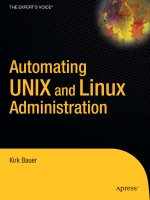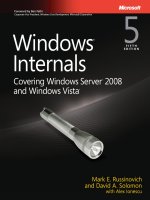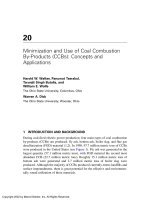Handbook of Wireless Networks and Mobile Computing phần 1 potx
Bạn đang xem bản rút gọn của tài liệu. Xem và tải ngay bản đầy đủ của tài liệu tại đây (526.73 KB, 65 trang )
HANDBOOK OF
WIRELESS NETWORKS
AND MOBILE COMPUTING
Handbook of Wireless Networks and Mobile Computing, Edited by Ivan Stojmenovic´
Copyright © 2002 John Wiley & Sons, Inc.
ISBNs: 0-471-41902-8 (Paper); 0-471-22456-1 (Electronic)
WILEY SERIES ON PARALLEL AND DISTRIBUTED COMPUTING
Series Editor: Albert Y. Zomaya
Parallel and Distributed Simulation Systems / Richard Fujimoto
Surviving the Design of Microprocessor and Multimicroprocessor Systems:
Lessons Learned / Veljko Milutinovic´
Mobile Processing in Distributed and Open Environments / Peter Sapaty
Introduction to Parallel Algorithms / C. Xavier and S. S. Iyengar
Solutions to Parallel and Distributed Computing Problems: Lessons from Bio-
logical Sciences / Albert Y. Zomaya, Fikret Ercal, and Stephan Olariu (Editors)
New Parallel Algorithms for Direct Solution of Linear Equations / C. Siva Ram
Murthy, K. N. Balasubramanya Murthy, and Srinivas Aluru
Practical PRAM Programming / Joerg Keller, Christoph Kessler, and
Jesper Larsson Traeff
Computational Collective Intelligence / Tadeusz M. Szuba
Parallel and Distributed Computing: A Survey of Models, Paradigms, and Ap-
proaches / Claudia Leopold
Fundamentals of Distributed Object Systems: A CORBA Perspective /
Zahir Tari and Omran Bukhres
Pipelined Processor Farms: Structured Design for Embedded Parallel Sys-
tems / Martin Fleury and Andrew Downton
Handbook of Wireless Networks and Mobile Computing /
Ivan Stojmenovic´ (Editor)
HANDBOOK OF
WIRELESS NETWORKS
AND MOBILE COMPUTING
Edited by
Ivan Stojmenovic´
University of Ottawa
Universidad Nacional Autonoma de México
A W
ILEY
-I
NTERSCIENCE
P
UBLICATION
JOHN WILEY & SONS, INC.
Designations used by companies to distinguish their products are often claimed as trademarks. In all instances
where John Wiley & Sons, Inc., is aware of a claim, the product names appear in initial capital or ALL CAPITAL
LETTERS. Readers, however, should contact the appropriate companies for more complete information regarding
trademarks and registration.
Copyright © 2002 by John Wiley & Sons, Inc. All rights reserved
No part of this publication may be reproduced, stored in a retrieval system or transmitted in any form or by any means, electronic
or mechanical, including uploading, downloading, printing, decompiling, recording or otherwise, except as permitted under
Sections 107 or 108 of the 1976 United States Copyright Act, without the prior written permission of the Publisher. Requests to
the Publisher for permission should be addressed to the Permissions Department, John Wiley & Sons, Inc., 605 Third Avenue,
New York, NY 10158-0012, (212) 850-6011, fax (212) 850-6008, E-Mail: PERMREQ @ WILEY.COM.
This publication is designed to provide accurate and authoritative information in regard to the
subject matter covered. It is sold with the understanding that the publisher is not engaged in
rendering professional services. If professional advice or other expert assistance is required, the
services of a competent professional person should be sought.
ISBN 0-471-22456-1
This title is also available in print as ISBN 0-471-41902-8.
For more information about Wiley products, visit our web site at www.Wiley.com.
Contents
Contributors xiii
Preface xvii
1 Handoff in Wireless Mobile Networks 1
Qing-An Zeng and Dharma P. Agrawal
1.1 Introduction 1
1.2 Types of Handoffs 1
1.3 Handoff Initiation 2
1.4 Handoff Decision 4
1.5 Handoff Schemes 4
1.6 Summary 24
References 24
2 Location Management in Cellular Networks 27
Jingyuan Zhang
2.1 Introduction 27
2.2 Cellular Networks 27
2.3 Location Management 29
2.4 Common Assumptions for Performance Evaluation 30
2.5 Location Management Schemes 34
2.6 Summary 46
Acknowledgments 47
References 47
3 Heuristics for Solving Fixed-Channel Assignment Problems 51
Harilaos G. Sandalidis and Peter Stavroulakis
3.1 Introduction 51
3.2 Resource Management Tasks 51
3.3 Interference in Cellular Systems 52
3.4 Frequency Management and Channel Assignment Issues 54
3.5 Channel Assignment 56
v
3.6 Fixed-Channel Assignment Problem 57
3.7 Heuristic Techniques for Combinatorial Optimization 60
3.8 Heuristic FCA Schemes 62
3.9 Conclusions 67
References 67
4 Channel Assignment and Graph Multicoloring 71
Lata Narayanan
4.1 Introduction 71
4.2 Preliminaries 74
4.3 Basic Types of Algorithms 77
4.4 Lower Bounds 78
4.5 The Static Case 82
4.6 The Online Case 90
4.7 Discussion and Open Problems 91
References 92
5 Channel Assignment and Graph Labeling 95
Jeannette C. M. Janssen
5.1 Introduction 95
5.2 Lower Bounds 99
5.3 Algorithms 104
5.4 Conclusions and Open Problems 114
Acknowledgments 115
References 115
6 Wireless Media Access Control 119
Andrew D. Myers and Stefano Basagni
6.1 Introduction 119
6.2 General Concepts 119
6.3 Wireless Issues 123
6.4 Fundamental MAC Protocols 124
6.5 Centralized MAC Protocols 127
6.6 Ad Hoc MAC Protocols 130
6.7 Summary 141
References 142
7 Traffic Integration in Personal, Local, and Geographical Wireless Networks 145
Raffaele Bruno, Marco Conti, and Enrico Gregori
7.1 Introduction 145
7.2 A Technology for WPAN: Bluetooth 147
7.3 Technologies for High-Speed WLANs 153
vi
CONTENTS
7.4 Third-Generation Cellular Systems: UMTS 160
Acknowledgments 168
References 168
8 Fair Scheduling in Wireless Packet Data Networks 171
Thyagarajan Nandagopal and Xia Gao
8.1 Introduction 171
8.2 Models and Issues 172
8.3 Wireless Fair Queueing Architecture 180
8.4 Algorithms for Wireless Fair Queueing 186
8.5 Issues and Future Directions 190
References 193
9 Randomized Initialization Protocols for Radio Networks 195
Koji Nakano and Stephan Olariu
9.1 Introduction 195
9.2 State of the Art 197
9.3 A Refresher of Basic Probability Theory 198
9.4 Energy-Efficient Prefix Sums Protocols 200
9.5 Initializing a Single-Channel RN 202
9.6 Initializing a k-Channel RN 207
9.7 Energy-Efficient Initialization Protocols 208
9.8 Concluding Remarks and Open Problems 215
Acknowledgments 216
References 216
10 Leader Election Protocols for Radio Networks 219
Koji Nakano and Stephan Olariu
10.1 Introduction 219
10.2 A Brief Refresher of Probability Theory 222
10.3 Oblivious Leader Election Protocols 224
10.4 Uniform Leader Election Protocols 227
10.5 Nonuniform Leader Election Protocol 234
10.6 Concluding Remarks and Open Problems 240
Acknowledgments 241
References 241
11 Data Broadcast 243
Jianliang Xu, Dik-Lun Lee, Qinglong Hu, and Wang-Chien Lee
11.1 Introduction 243
11.2 Data Scheduling 245
11.3 Air Indexing 253
CONTENTS vii
11.4 Other Issues 260
11.5 Summary 262
Acknowledgments 262
References 263
12 Ensemble Planning for Digital Audio Broadcasting 267
Albert Gräf and Thomas McKenney
12.1 Introduction 267
12.2 The Ensemble Planning Problem 268
12.3 Basic Solution Techniques 271
12.4 Lower Bounds 273
12.5 A Tabu Search Method 274
12.6 Conclusion 286
Acknowledgments 287
References 287
13 Transport over Wireless Networks 289
Hung-Yun Hsieh and Raghupathy Sivakumar
13.1 Introduction 289
13.2 Overview of TCP 291
13.3 TCP over Wireless Networks 293
13.4 Approaches to Improve Transport Layer Performance 297
13.5 Summary 306
References 307
14 Security and Fraud Detection in Mobile and Wireless Networks 309
Azzedine Boukerche
14.1 Introduction 309
14.2 Network Security Problems 310
14.3 Network Security Management Plan 311
14.4 Intrusion Detection Systems (IDS) 311
14.5 Securing Data Transfer in Digital Mobile Systems 312
14.6 Securing Wireless Ad Hoc Networks 313
14.7 Authentication of Mobile Users 315
14.8 Subscription and Fraud Detection in Mobile Phone Systems 317
14.9 Conclusion 321
References 322
15 Mobile Ad Hoc Networks 325
Silvia Giordano
15.1 Introduction 325
15.2 Layered Architecture of Mobile Ad Hoc Networks 327
viii
CONTENTS
15.3 MAC Layer 331
15.4 Mobile Ad Hoc Networks and the Internet 335
15.5 Routing in Self-Organized Networks 339
15.6 People-Based Networks 341
15.7 Conclusion 342
Acknowledgments 343
References 343
16 Broadcast Scheduling for TDMA in Wireless Multihop Networks 347
Errol L. Lloyd
16.1 Introduction 347
16.2 What Is Broadcast Scheduling? 347
16.3 The Complexity of Broadcast Scheduling 351
16.4 Centralized Algorithms 352
16.5 Distributed Algorithms 359
16.6 Related Results 366
16.7 Summary and Open Problems 368
Acknowledgments 368
References 368
17 Mobile Ad Hoc Networks and Routing Protocols 371
Yu-Chee Tseng, Wen-Hua Liao, and Shih-Lin Wu
17.1 Introduction 371
17.2 Unicast Routing Protocols for MANET 372
17.3 Broadcasting Protocols for MANET 381
17.4 Multicasting Protocols for MANET 383
17.5 QoS Routing 385
17.6 Extending Cellular Systems with Ad Hoc Links 389
17.7 Conclusions 390
Acknowledgments 391
References 391
18 Routing with Guaranteed Delivery in Geometric and 393
Wireless Networks
Jorge Urrutia
18.1 Introduction 393
18.2 Applications to Ad Hoc Wireless Communication Networks 401
18.3 Delaunay Triangulations 403
18.4 Conclusions 404
Acknowledgments 404
References 404
CONTENTS ix
19 Power Optimization in Routing Protocols for Wireless and 407
Mobile Networks
Stephanie Lindsey, Krishna M. Sivalingam, and Cauligi S. Raghavendra
19.1 Introduction 407
19.2 Background 408
19.3 Energy Analysis of AODV and DSR Routing Protocols 409
19.4 Power-Aware Routing Metrics 413
19.5 Routing Based on Balanced Energy Consumption of Nodes 417
19.6 Broadcast and Multicast Tree Construction 418
19.7 Topology Control Using Transmit Power Adjustment 419
19.8 Summary 421
Acknowledgments 421
References 421
20 Dominating-Set-Based Routing in Ad Hoc Wireless Networks 425
Jie Wu
20.1 Introduction 425
20.2 Preliminaries 427
20.3 Formation of a Connected Dominating Set 431
20.4 Extensions 438
20.5 Conclusions and Future Directions 447
Acknowledgments 448
References 448
21 Location Updates for Efficient Routing in Ad Hoc Networks 451
Ivan Stojmenovic´
21.1 Introduction 451
21.2 Classification of Routing Algorithms 452
21.3 Location Updates Between Neighboring Nodes 457
21.4 Request Zone Routing 458
21.5 Doubling Circles Routing 459
21.6 Quorum-Based Strategies 460
21.7 Home-Agent-Based Strategy 463
21.8 Performance Evaluation Issues 465
21.9 Conclusion 468
References 468
22 Topological Design, Routing, and Handover in Satellite Networks 473
Afonso Ferreira, Jérôme Galtier, and Paolo Penna
22.1 Introduction 473
22.2 Topologies 473
x
CONTENTS
22.3 Network Mobility and Traffic Modeling 478
22.4 Routing and Handover 484
22.5 Conclusions 491
Acknowledgments 491
References 491
23 Multicasting: From Fixed Networks to Ad Hoc Networks 495
Thomas Kunz
23.1 Introduction 495
23.2 Motivation 495
23.3 Multicasting in Fixed/Wired Networks 497
23.4 Multicasting in Fixed Infrastructure Cellular Networks 497
23.5 Multicasting in Mobile Ad Hoc Networks: Adopting Wireless 500
Protocols
23.6 Multicasting in Mobile Ad Hoc Networks: MANET-Inspired 502
Multicast Protocols
23.7 Conclusions 506
Acknowledgments 508
References 508
24 Broadcasting in Radio Networks 509
Andrzej Pelc
24.1 Introduction 509
24.2 Communication Scenarios 510
24.3 The Graph Model 512
24.4 The Geometric Model 519
24.5 Other Variants of the Problem 521
24.6 Conclusion and Open Problems 525
Acknowledgments 526
References 526
25 Mobile IP Protocols 529
Christos Douligeris and Thanos Vasilakos
25.1 Introduction 529
25.2 Mobility Requirements and Constraints in an IP Environment 530
25.3 Mobile IP Protocol Overview 531
25.4 Route Optimization 544
25.5 Mobility Support for IPv6 546
25.6 Connectivity with 3G Networks 547
25.7 Management of Information Bases 549
25.8 Conclusions 550
References 551
CONTENTS xi
26 Data Management in Wireless Mobile Environments 553
Sandeep K. S. Gupta and Pradip K. Srimani
26.1 Introduction 553
26.2 Data Management Issues in Mobile Environments 555
26.3 Caching of Data 555
26.4 An Informal Overview 557
26.5 Formal Description of the Scheme 564
26.6 Performance Analysis 566
26.7 Performance Comparison 570
26.8 Summary 574
Acknowledgments 578
References 578
27 Mobile, Distributed, and Pervasive Computing 581
Michel Barbeau
27.1 Introduction 581
27.2 Pervasive Computing Applications 582
27.3 Architecture of Pervasive Computing Software 583
27.4 Open Protocols 584
27.5 Summary 598
Acknowledgments 599
References 599
28 Indoor Wireless Environments 601
Lakshmi Ramachandran
28.1 Introduction 601
28.2 The Physical Layer 602
28.3 Media Access Control 604
28.4 Network Topology 615
28.5 Characterization of the Environment 620
28.6 Challenges for the Future: Nomadic Computing 621
28.7 Summary 621
Acknowledgments 621
References 622
Index 625
xii
CONTENTS
Contributors
Dharma P. Agrawal, University of Cincinnati, Department of Electrical Engineering and
Computer Science, Cincinnati, Ohio 45221
Michel Barbeau, Carleton University, School of Computer Science, Ottawa, Ontario KIS
5B6, Canada
Stefano Basagni, University of Texas at Dallas, Department of Computer Science,
Richardson, Texas 75083
Azzedine Boukerche, University of North Texas, Department of Computer Science, Den-
ton, Texas 762034
Raffaele Bruno, Consiglio Nazionale delle Ricerche (CNR), Istituto CNUCE, 56010
Ghezzano, Pisa, Italy
Marco Conti, Consiglio Nazionale delle Ricerche (CNR), Istituto CNUCE, 56010 Ghez-
zano, Pisa, Italy
Christos Douligeris, Institute of Computer Science, FORTH, Heraklion, Crete, Greece
Afonso Ferreira, CNRS Mascotte, 13S INRIA Sophia Antipolis, BP 93, F-06902 Sophia
Antipolis Cedex, France
Jérôme Galtier, France Telecom R&D and CNRS Mascotte, 13S INRIA Sophia Antipo-
lis, BP 93, F-06902 Sophia Antipolis Cedex, France
Xia Gao, University of Illinois at Urbana-Champaign, Coordinated Science Laboratory,
Urbana, Illinois 61801
Silvia Giordano, Swiss Federal Institute of Technology, Institute of Computer Communi-
cations and Applications, CH-1015 Lausanne, Switzerland
Albert Gräf, Johannes Gutenberg University, Department of Music Informatics, 55099
Mainz, Germany
xiii
Enrico Gregori, Consiglio Nazionale delle Ricerche (CNR), Istituto CNUCE, 56010
Ghezzano, Pisa, Italy
Sandeep K. S. Gupta, Arizona State University, Department of Computer Science and
Engineering, Tempe, Arizona 85287
Hung-Yun Hsieh, Georgia Institute of Technology, School of Electrical and Computer
Engineering, Atlanta, Georgia 30332
Qinglong Hu, IBM Almaden Research Center, San Jose, California
Jeannette C. M. Janssen, Dalhousie University, Department of Mathematics and Statis-
tics, Halifax, Nova Scotia B3H 3J5, Canada
Thomas Kunz, Carleton University, Systems and Computer Engineering, Ottawa, Ontario
K1S 5B6, Canada
Dik-Lun Lee, Hong Kong University of Science and Technology, Department of Comput-
er Science, Clear Water Bay, Hong Kong
Wang-Chien Lee, Verizon Laboratories, Waltham, Massachusetts
Wen-Hua Liao, National Central University, Department of Computer Science and Infor-
mation Engineering, Tao-Yuan, Taiwan
Stephanie Lindsey, Washington State University, School of Electrical Engineering and
Computer Science, Pullman, Washington 99l64
Errol L. Lloyd, University of Delaware, Department of Computer Science and Informa-
tion Sciences, Newark, Delaware 19716
Andrew D. Myers, University of Texas at Dallas, Department of Computer Science,
Richardson, Texas 75083
Thomas McKenney, Johannes Gutenberg University, Department of Music Informatics,
55099 Mainz, Germany
Koji Nakano, Japan Advanced Institute for Science and Technology
Thyagarajan Nandagopal, University of Illinois at Urbana-Champaign, Coordinated Sci-
ence Laboratory, Urbana, Illinois 61801
Lata Narayanan, Concordia University, Department of Computer Science, Montreal,
Quebec H3G 1M8, Canada
xiv
CONTRIBUTORS
Stephan Olariu, Old Dominion University, Department of Computer Science, Norfolk,
Virginia 23529
Andrzej Pelc, Unversité du Québec à Hull, Departement d’Informatique, Hull, Québec
J8X 3X7, Canada
Paolo Penna, CNRS Mascotte, 13S INRIA Sophia Antipolis, BP 93, F-06902 Sophia An-
tipolis Cedex, France
Cauligi S. Raghavendra, University of Southern California, Department of Electrical
Engineering, Los Angeles, California 90089
Lakshmi Ramachandran, Trillium Digital Systems, International Tech Park, Bangalore
560 066, India
Harilaos G. Sandalidis, Telecommunications Systems Institute, 37 Iroon Polytechniou
Str., Crete, Greece
Raghupathy Sivakumar, Georgia Institute of Technology, School of Electrical and Com-
puter Engineering, Atlanta, Georgia 30332
Krishna M. Sivalingam, Washington State University, School of Electrical Engineering
and Computer Science, Pullman, Washington 99164
Pradip K. Srimani, Clemson University, Department of Computer Science, Clemson,
South Carolina 29634
Peter Stavroulakis, Telecommunications Systems Institute, 37 Iroon Polytechniou Str.,
Crete, Greece
Ivan Stojmenovic´, DISCA, IIMAS, Universidad Nacional Autonoma de Mexico, Mexico
D.F., Mexico
Yu-Chee Tseng, National Chiao-Tung University, Department of Computer Science and
Information Engineering, Hsin-Chu 300, Taiwan
Jorge Urrutia, Universidad Nacional Autonoma de Mexico, Instituto de Matematicas,
Mexico D.F., Mexico
Thanos Vasilakos, FORTH, Institute of Computer Science, Heraklion, Crete, Greece
Jie Wu, Florida Atlantic University, Department of Computer Science and Engineering,
Boca Raton, Florida 33431
Shih-Lin Wu, Chang Gung University, Department of Electrical Engineering, Tao-Yuan,
Taiwan
CONTRIBUTORS xv
Jianliang Xu, Hong Kong University of Science and Technology, Department of Comput-
er Science, Clear Water Bay, Hong Kong
Qing-An Zeng, University of Cincinnati, Department of Electrical Engineering and Com-
puter Science, Cincinnati, Ohio 45221
Jingyuan Zhang, University of Alabama, Department of Computer Science, Tuscaloosa,
Alabama 35487
xvi
CONTRIBUTORS
Preface
The past five decades have witnessed startling advances in computing and communica-
tion technologies that were stimulated by the availability of faster, more reliable, and
cheaper electronic components. The design of smaller and more powerful devices en-
abled their mobility, which is rapidly changing the way we compute and communicate.
For instance, the worldwide number of cellular phone subscribers has quadrupled in the
last five years and has grown to over half a billion (see www.gsmdata.com). Wireless
and mobile networks are emerging as networks of choice, due to the flexibility and
freedom they offer. The use of satellite, cellular, radio, sensor, and ad hoc wireless net-
works, wireless local area networks (LAN), small portable computers, and personal
communication systems (PCS) is increasing. These networks and devices support a trend
toward computing on the move, known as mobile computing, nomadic computing, or
computing anywhere anytime. The applications of mobile computing and wireless net-
works include e-commerce, personal communications, telecommunications, monitoring
remote or dangerous environments, national defense (monitoring troop movements),
emergency and disaster operations, remote operations of appliances, and wireless
Internet access.
This handbook is based on a number of self-contained chapters and provides an oppor-
tunity for practitioners and researchers to explore the connection between various comput-
er science techniques and develop solutions to problems that arise in the rapidly emerging
field of wireless networks. The mobile computing area deals with computing and commu-
nication problems that arise in packet radio networks, mobile cellular systems, personal
communication systems, and wireless local area networks. The main direction of the book
is to review various algorithms and protocols that have been developed in this area, with
emphasis on the most recent ones.
This book is intended for researchers and graduate students in computer science and
electrical engineering, and researchers and developers in the telecommunications industry.
Although much has been written, especially recently, in this rapidly growing field, no oth-
er book treats problems in wireless networks from a computer science perspective, al-
though a number of books that follow the engineering approach exist. The editor taught a
computer science graduate course with the same title and contents as this handbook, but
was not able to find any book that covered even half of the topics covered here (the course
outline and transparencies for lectures given by me in the course can be found at
www.site.uottawa.ca/~ivan). This handbook can be used as a textbook and a reference for
use by students, researchers, and developers.
xvii
MOBILE AND WIRELESS NETWORKING ISSUES
Mobile users do not necessarily use wireless interfaces. Instead, they can simply connect
to fixed networks with a wired interface while away from their home or office. On the oth-
er hand, a fixed-location user may use a wireless interface (via a LAN) in an office envi-
ronment. Other examples include wireless local loops, which provide fixed wireless ac-
cess for voice and data transfer and high-speed Internet access. Wireless networks may
use a fixed infrastructure as a backbone. For instance, cellular networks connect a mobile
phone to the nearest base station (BS). A BS serves hundreds of mobile users in a given
area (cell) by allocating frequencies and providing hand-off support. BSs are linked (by
wireline, fiberline, or wireless microwave links) to base station controllers that provide
switching support to several neighboring BSs and serve thousands of users. Controllers
are in turn connected to a mobile switching center that is capable of serving more than
100,000 users. Mobile switching centers are finally connected directly to the public ser-
vice telephone network (PSTN). Therefore only the first and perhaps the last connection
(if the other user is also using a mobile phone) are normally wireless. However, the wire-
less link poses design challenges. The main difference between wired and wireless links is
in the type of communication. Wired links normally provide one-to-one communication
without interference, whereas wireless links use one-to-many communication that has a
considerable noise and interference level and bandwidth limitations. Simultaneous wire-
less communications require channel separation, where channel may refer to time, fre-
quency, or code. The channel capacity typically available in wireless systems is much low-
er than what is available in wired networks. The regulated frequency spectrum further
limits the number of users that can be served concurrently. Mobile devices use battery
power, and limited power resources pose further design challenges. High noise levels
cause larger bit-error rates. Forward error correction algorithms or error detection
schemes (such as cyclic redundancy control) followed by buffering and selective retrans-
mission must be used. One-to-many free space communication is also insecure, since a
third party may easily receive the same messages. Encryption and decryption procedures
that provide security require, at the same time, significant power and bandwidth resources.
Some wireless networks do not have a fixed infrastructure as a backbone. Examples are
ad hoc networks, sensor networks, and wireless LANs. Wireless networks of sensors are
likely to be widely deployed in the near future because they greatly extend our ability to
monitor and control the physical environment from remote locations and improve the ac-
curacy of information obtained via collaboration among sensor nodes and online informa-
tion processing at those nodes. Networking these sensors (empowering them with the abil-
ity to coordinate among themselves on a larger sensing task) will revolutionize
information gathering and processing in many situations. Sensors are normally small,
cheap devices with limited computing power. The typical size of a sensor is about one cu-
bic centimeter. However, the SmartDust project is attempting to determine whether an au-
tonomous sensing, computing, and communication system can be packed into a cubic mil-
limeter mote to form the basis of integrated, massively distributed sensor networks.
Sensors can be placed in an indoor environment at convenient locations. Alternatively,
hundreds or thousands of them can be placed in a field. For example, sensor nodes can be
air-dropped from a helicopter to cover an open field and report on vehicular activity or
xviii
PREFACE
troop movement. Each node contains one or more of the following sensor types: acoustic,
seismic, magnetic, infrared, and visual imaging. Once the sensors are in place, each of
them can detect neighboring sensors and decide about their transmission radius so that the
number of sensors receiving signals is within some limit. This is a nontrivial problem in it-
self. For instance, a recently published algorithm, in which each node transmits hello mes-
sages using radius kr, where r is a fixed small radius and k is modified until the number of
responses is within limits, is not deterministic, has collision problems, and does not guar-
anty the process convergence or connectivity of the obtained network.
Sensors should alternate between sleeping and active periods so that the life of each
sensor, and overall network life, is maximized. They could be divided into clusters for fur-
ther power savings.
The detection and reporting of target movements is also a nontrivial problem. If every
sensor that detects movement reports it to a center, too many messages are generated,
causing collision problems and reducing sensor energy too quickly. A recently proposed
algorithm (which assumes that each sensor knows its own geographic location and is able
to detect the direction of an object that is “visible”) suggests that all nodes whose neigh-
boring nodes lie on the same side of a straight line from the node to the detected object
should report the object’s presence. It was expected that there would be exactly two such
nodes (located at tangents from the object to the convex hull of the sensors). This solution,
however, may activate more sensors (the criteria can be satisfied for more nodes) or may
not activate any sensor at all (for example, when the object is located inside the convex
hull of the sensors). Even when exactly two such sensors are selected, the sensors could be
too close to the line segment between them, causing computational errors in object loca-
tion based on two object directions. An alternative solution is to select only locally ex-
treme sensors in four directions (N, S, E, and W) or possibly eight directions (including
NW, NE, SW, and SE), and to combine the data obtained along the paths from them to a
center that collects the data. Sensors that combine data will only forward “significant” im-
provements in the object’s location. We can envision similar applications for monitoring
environmental pollutants and their source and direction of movement. Several computer
science projects along these lines (e.g., sensor information technology, diffusion-based
networking, mobile scripts for target tracking, queries for collaborative signal processing),
are currently ongoing (www.darpa.mil/ito/research/sensit, /> www.cs.columbia.edu/dcc/asn, etc.).
A similar wireless network technology that has received significant attention in recent
years is the ad hoc network. Mobile ad hoc networks consist of wireless hosts that com-
municate with each other in the absence of a fixed infrastructure. They are used in disaster
relief, conferences, and battlefield environments. Wireless LANs are designed to operate
in a small area such as a building or office complex. The communication between two
hosts in wireless LANs, sensor, and ad hoc networks is not always direct. Hosts in wireless
LANs, sensor, and ad hoc networks use the same frequency for communication. Direct (or
single-hop) transmission between any two hosts may require significant power (power
normally decreases with the square or higher degree of distance between hosts) and is
prone to collisions with other such transmissions. Thus, two hosts normally communicate
via other hosts in the network (multihop communication). The solution to this involves
solving routing problems. Collisions are difficult to detect because of the hidden station
PREFACE xix
problem. Two hosts that do not communicate directly may simultaneously transmit mes-
sages to a common neighbor, causing collision. Mobile networks should provide support
for routing by maintaining communication during mobility. In order to maintain an ongo-
ing routing task (e.g., ongoing phone call) or to facilitate route establishment or paging,
mobile networks must also provide support for location management, that is, keeping
track of the host location.
The performance of wireless networks greatly depends on the choice of the medium
access control (MAC) scheme. For instance, MAC protocols used in cellular networks in
the United States and Europe differ. The IS-95 standard used in the United States uses
code division multiple access (CDMA), whereas the GSM standard used in Europe uses
TDMA (time division multiple access) on the top of FDMA (frequency DMA). CDMA
provides more channels but at the expense of more noise and interference. These differ-
ences prevent interoperability and global mobility, and also create obstacles to standard-
ization of the third generation (3G) of cellular systems.
Ad hoc, sensor, and wireless local area networks may use the IEEE 802.11 standard for
medium access, in which hosts wait for a randomly selected number of transmission-
free slots (back-off counter) before transmitting a message. Other standards (e.g.,
HIPERLAN) are also available. One emerging MAC layer technology is Bluetooth
(www.bluetooth.net). It provides short-range (about 10 meters), low-cost wireless connec-
tivity among hosts such as computers, printers, scanners, PCs, or sensors. In Bluetooth en-
vironments, hosts are organized into piconets, with one host in each piconet serving as
master and a limited number (up to seven) of slave hosts directly linked to the master.
Satellites are in wide use for broadcast services and long distance and international
phone services to stationary users. Low-earth orbit (LEO) satellite systems, such as
Teledesic (expected to be operational in 2003 and consisting of 288 satellites), will pro-
vide mobile communications to every point on earth. Satellites are organized in concentric
orbits and maintain links with several satellites in neighboring orbits and nearest satellites
in the same orbit.
Wireless ATM (asynchronous transfer mode) is an emerging technology for support of
voice and data transmission. ATM connections rely partly on wireless networks. New
challenges in the design of wireless ATM include varying channel characteristics, quality
of service support, and support of end-to-end ATM connection as the user moves from one
location to the other. ATM is a connection-oriented technology, so after a mobile user’s
move to a new location, connection rerouting has to be performed. In a cellular network or
ATM connections, location management schemes are needed in order to provide updated
location information when a connection to a mobile user needs to be set up (routed) or
rerouted.
The Wireless Application Protocol (WAP, www.wapforum.org) allows the development
of applications that are independent of the underlying wireless access technology, and
adapts existing website contents for transmission over wireless links and display on mo-
bile devices. WAP architecture consists of a mobile client that sends an encoded request to
a gateway and receives an encoded response from the gateway via a wireless network. The
gateway, in turn, sends a request to a server and receives a response (content) from it over
a wired network. WAP consist of application, session, transaction, security, transport, and
wireless layers. Mobile devices require mobile operating systems (OSs) that are small in
xx
PREFACE
size and memory (e.g., 300 KB) and are able to operate with little processing power and
satisfy real-time requirements, such as voice traffic.
BRIEF OUTLINE OF THIS HANDBOOK
The wide range of topics in this handbook makes it an excellent reference on wireless net-
works and mobile computing. Because each chapter is fully self-contained, readers can fo-
cus on the topics that most interest them. Most of the chapters (if not all) in this handbook
have great practical utility. The handbook emphasizes computer science aspects, including
implementation. Mathematical and engineering aspects are also represented in some chap-
ters, since it is difficult to separate clearly all the issues among the three areas. Even when
other aspects are clearly dominant, they are a good supplement to the rest of the hand-
book.
A short outline of the material presented in each of the chapters of this volume follows.
The purpose is to identify the contents and also to aid diverse readers in assessing just
what chapters are pertinent to their pursuits and desires. Each chapter should provide the
reader with the equivalent of consulting an expert in a given discipline by summarizing
the state of the art, interpreting trends, and providing pointers to further reading.
It is a challenging task to clearly divide chapters into discrete areas because of over-
laps. One such classification that will be attempted here is to divide the chapters into five
main research areas: multiple access schemes, cellular networks, data communication,
multihop networks, and mobile computing. Many chapters deal with more than one of
these areas, so clear separation is difficult. As a quick guide through the chapter topics,
the first half of the chapters deal with multiple access schemes, data communication, and
cellular networks; and other half deal with multihop networks and mobile computing. We
shall now elaborate in more detail on each chapter, and try to group chapters into the five
listed areas.
Cellular networks were certainly the first and so far most successful commercial appli-
cation of wireless networks. The research in this area is hence more advanced than in the
others. Nevertheless, it remains a hot research topic because of emerging technologies
such as the third generation (3G) of mobile phone systems. Chapters 1–5 deal primarily
with cellular networks.
Chapter 1 discusses handoff, which is the mechanism for transferring an ongoing call
from one base station to another as a user moves through the coverage area of a cellular
system. It must be fast and efficient to prevent the quality of service from degenerating to
an unacceptable level. Admission control is a related problem, in which the radio resource
management system has to decide if a new call arrival or a request for service or handoff
may be allowed into the system. Handoffs are normally prioritized with respect to new
calls. Four conventional handoff schemes in a voice-based, single traffic system (nonpri-
ority schemes, priority schemes, handoff call queuing schemes, and originating and hand-
off calls queuing schemes) are summarized in this chapter. In addition, two handoff
schemes with and without preemptive priority procedures for integrated voice and data
wireless mobile networks are also covered in detail.
Mobile phone users move among base stations but do not always register with the cur-
PREFACE xxi
rent base station, to avoid communication overhead and excessive battery use. There exists
a trade-off between the frequency of location update by the mobile phone user and the de-
lay in locating a user when a phone call is made. Chapter 2 reviews existing solutions to
the location management problem.
Chapters 3, 4, and 5 discuss the media access control problem in cellular networks.
They are therefore at the intersection of the first two research areas of this handbook—
multiple access schemes and cellular networks. Media access control in cellular networks
is achieved primarily by assigning different frequencies to users that are connected to the
same or neighboring base stations, and repeating the same frequencies when the corre-
sponding base stations are sufficiently far apart to avoid or minimize the interference.
Chapter 3 describes fixed-channel assignment schemes in cellular networks, with the
emphasis on recent heuristic algorithms that apply genetic algorithms, tabu search, neural
networks, fuzzy logic, and other heuristics in solving problems. Channel assignment is
generally classified into fixed and dynamic. In fixed channel assignment (FCA), channels
are nominally assigned in advance according to the predetermined estimated traffic inten-
sity at various base stations. In dynamic channel assignment (DCA), channels are as-
signed dynamically as calls arrive. It is more efficient in terms of channel usage, but re-
quires more complex and time-consuming control. Hybrid channel assignment (HCA)
combines the two approaches by dividing the frequencies into two separate ranges, one for
FCA and other for DCA. In borrowing channel assignment (BCA), the channel assign-
ment is initially fixed. If there are incoming calls for a cell whose channels are all occu-
pied, the cell borrows channels from its neighboring cells and thus call blocking is pre-
vented.
Cochannel interference is the most critical of all interference that occurs in cellular ra-
dio. The same channel cannot be assigned to two users that are connected to the same or
two “close” base stations since such cochannel interference is likely to cause an unaccept-
able signal-to-noise ratio. The minimal distance between two base stations that can use the
same channel is called the reuse distance. If this is the only type of interference consid-
ered, the channel assignment problem reduces to a multicoloring problem. In a multicolor-
ing problem defined on a graph, each base station is demanding a certain number of col-
ors (that is, frequencies), so that any two neighboring nodes get a disjoint set of colors
(and, of course, colors assigned to each node are all distinct). When translated to cellular
systems, nodes are base stations, and two base stations are “neighbors” in graph terms if
the distance between then is less than the reuse distance. Chapter 4 studies this simplified
version of the famous graph coloring problem that is known to be computationally diffi-
cult. Algorithms and lower bounds for this problem (including FCA, DCA, BCA, and
HCA problem statements) are surveyed.
The secondary source of interference in cellular systems is adjacent channel interfer-
ence. The filters for each channel at base stations are not ideal, and allow the signals from
neighboring channels, with reduced strength, to generate noise. In a general problem
statement, two base stations (i.e., cells) that are at a distance i (where i is the minimal
number of cell crossings between two cells) cannot be assigned two frequencies that differ
by less than c
i
. The cosite constraint c
0
indicates the channel separation at the same base
station, which is normally high compared to other constraints. The intersite constraints c
i
(i > 0) most often take smaller values, especially one or two. An intersite constraint of one
xxii
PREFACE
indicates that the two base stations must use distinct frequencies, whereas zero constraint
indicates that the two cells may reuse frequencies. More precisely, in a good channel as-
signment, they actually should reuse the frequencies. Chapter 5 gives an overview of algo-
rithms and lower bounds for this problem. It also discusses relevant results on graph label-
ing, which form the basis of many of the algorithms.
Several chapters deal with multiple access schemes. Since the wireless medium is in-
herently a shared resource, controlling channel access becomes a central theme that deter-
mines the system capacity, complexity, and cost. Chapter 6 focuses on the design and im-
plementation of media access control (MAC) protocols for cellular telephony, wireless
ATM, and ad hoc networks. Fundamental MAC protocols include frequency division mul-
tiple access (FDMA), time division multiple access (TDMA), code division multiple ac-
cess (CDMA), and random access schemes such as ALOHA and carrier sense multiple ac-
cess (CSMA).
Chapter 7 discusses the integration of voice and data traffic in wireless networks. It
concentrates on Bluetooth technology (the de facto standard for wireless personal area
networks), IEEE 802.11 technology (the main standard for wireless local area networks),
and the UMTS technology for third generation cellular systems.
Fairness among mobile or wireless users implies that the allocated channel bandwidth
is in proportion to the “weights” of the users. Fair queuing in the wireless domain poses
significant challenges due to unique issues in the wireless channel such as location-depen-
dent and bursty channel error. Hence, it is imperative to provide fair channel access
among multiple contending hosts. Chapter 8 identifies key issues in wireless fair queuing,
defines a wireless fair service model, and surveys algorithms from contemporary litera-
ture.
Chapters 9 and 10 deal with organization issues for medium access in radio networks,
which are distributed systems with no central arbiter, consisting of n radio transceivers,
also called stations. The wireless environment is single-hop one, meaning that each station
is able to hear a transmission from any other station. The time is slotted, and all transmis-
sions occur at slot boundaries. Chapter 9 describes how each station can assign to itself a
unique identifier in the range [1, n] so that the i-th user is able to transmit the message in
the i-th slot. This provides collision-free TDMA transmission in a round robin fashion.
The algorithms are distributed, and their analysis is based on combinatorial facts of bino-
mial distribution, tree partitions, and graphs. Initialization protocols with and without col-
lision detection capabilities, and using one of several channels for communication, are
presented. The leader election problem designates one of the stations as leader. Chapter 10
surveys recent protocols on the leader election problem in single-hop, single-channel ra-
dio networks.
Chapters 10–14 deal primarily with data communication issues in wireless networks,
with considerable overlap with all other listed areas.
Mobile wireless environments are characterized by asymmetric communication. The
downlink communication from base station, satellite, or other server is much greater than
the uplink communication capacity. In broadcast, data are sent simultaneously to all users
residing in the broadcast area. Each user in a data broadcast problem has a list of desired
files or data it wants to receive from the server. The order and frequency for each file or
datum that is broadcast should take access efficiency and power conservation into ac-
PREFACE xxiii
count. Access efficiency concerns how fast a request is satisfied, whereas power conserva-
tion concerns how to reduce a mobile client’s power consumption when it is accessing the
data it wants. Chapter 11 surveys various techniques and problem formulations for wire-
less data broadcast, sometimes also refereed to as broadcast scheduling.
Digital broadcasting systems are expected to replace current FM radio and television
technology. Chapter 12 considers the design of DAB (digital audio broadcasting) net-
works. The DAB system transmits whole ensembles consisting of multiple radio programs
and other data services, and allows an ensemble to be transmitted on a single channel even
if the corresponding transmitters may interfere. The task is to arrange services into a col-
lection of ensembles for each request area, and to assign channels to the resulting ensem-
bles. The problem can be formulated as the combined bin packing and graph coloring
problem. Several basic heuristics, lower bounding algorithms, and the tabu search solution
are described.
With the increasing number of wireless and mobile devices using the Internet, re-
searchers have been studying the impact of wireless networking technologies on the dif-
ferent layers of the network protocol stack. Chapter 13 focuses on the transport layer in
microcell and macrocell wireless networks. The task in the transport layer is to organize
the speed of transmissions, acknowledgment, and possible retransmissions of every pack-
et of a data transfer. It deals primarily with the network congestion problem. The unique
characteristics of wireless networks that result in poor performance for existing protocol
standards are identified (such as reduced bandwidth, which needs to be distinguished
from congestion), and approaches that have been proposed to address these characteristics
are surveyed.
Chapter 14 focuses on security and fraud detection problems in mobile and wireless
networks, and presents some solutions to several aspects of the security problem, such as
authentication of mobile users and fraud detection in mobile phone operations. Further in-
creases in network security are necessary before the promise of mobile telecommunica-
tion can be fulfilled.
Chapters 14–24 deal with multihop wireless networks. Their primary characteristic is
that mobile or wireless stations, phones, users, sensors, or other devices (let us call them
nodes) cannot communicate directly with any other node in the network. Thus, they com-
municate with each other via other nodes, through several hops. The network is then mod-
eled by a graph where two nodes are linked if and only if they can directly communicate.
If that graph is a complete graph (where each node can directly communicate to any other
node), the network is called a single-hop one. Cellular networks and transport protocols
also deal with multihop networks, but the problems studied and solution presented are not
significantly based on the underlying graph model.
Ad hoc networks are a key to the evolution of wireless networks. They are typically
composed of equal nodes that communicate over wireless links without any central con-
trol. Ad hoc wireless networks inherit the traditional problems of wireless and mobile
communications, such as bandwidth optimization, power control, and transmission quality
enhancement. In addition, the multihop nature and the lack of fixed infrastructure bring
new research problems such as configuration advertising, discovery and maintenance, as
well as ad hoc addressing and self-routing. Many different approaches and protocols have
been proposed and there are even multiple standardization efforts within the Internet En-
xxiv
PREFACE
gineering Task Force, as well as academic and industrial projects. Chapter 15 focuses on
the state of the art in mobile ad hoc networks. It highlights some of the emerging tech-
nologies, protocols, and approaches (at different layers) for realizing network services for
users on the move in areas with possibly no preexisting communications infrastructure.
People-based networks, where information is transmitted using “people” (i.e., personal
devices such as personal digital assistants), are also discussed.
To avoid interference of signals arriving from several neighbors to a single host, or si-
multaneous transmissions from two neighboring hosts, each host should create its own
transmission schedule. That is, each host should decide which time slots are available for
collision-free transmissions. Chapter 16 explores the computational and algorithmic com-
plexity of broadcast scheduling, which, in general form, is an NP-complete problem. The
chapter reviews existing broadcast scheduling approximation, off-line and on-line, and
centralized and distributed algorithms, and discusses their effect on the quality of the
schedules produced.
In a wireless network, routing the message (finding a path between a source and a des-
tination node) is a basic data communication protocol. A mobile ad hoc network consists
of a set of mobile hosts capable of communicating with each other without the assistance
of base stations. Chapter 17 reviews the existing routing algorithms for networks consist-
ing of nodes that do not have information about their geographic position.
Recently, the location of a sensor or station was made feasible by adding a GPS low-
power, small-size receiver that is able of determining its location (latitude, longitude, and
height) within a few millimeters by cooperating with existing satellite and auxiliary earth
networks. GPS also provides global timing to stations. Position information enables devel-
opment of localized routing methods (greedy routing decisions are made at each node,
based solely on the knowledge of positions of neighbors and the destination, with consid-
erable savings in communication overhead and with guaranteed delivery provided location
update schemes are efficient for a given movement pattern). When GPS is not available,
the relative position of neighboring nodes may be determined based on strength of signals
from neigboring nodes, or some other alternative means. Chapter 18 surveys routing algo-
rithms in communication networks, where nodes are aware of their geographic position
and those of their neigboring nodes. The algorithms take advantage of geometric proper-
ties of planar networks, constructing a planar subgraph of a given wireless network. Guar-
anteed delivery is a salient property of the algorithms, assuming destination location is ac-
curate and the network is modeled by unit graphs. In a unit graph, all nodes have the same
transmission radius, and two nodes can directly communicate if and only if their distance
is less than that radius.
Chapter 19 surveys energy-efficient routing protocols for wireless ad hoc networks. It
includes evaluation of energy consumption in ad hoc routing protocols, localized routing
algorithms that optimize based on power and other metrics, network topology generation
designed to optimize power consumption, routing algorithms that balance power con-
sumption among all network nodes, and algorithms that maximize nodes’ lifetimes.
A set of nodes in a network is dominating if all the nodes in the system are either in the
set or neighbors of nodes in the set. Chapter 20 reviews simple and efficient distributed al-
gorithms for calculating a connected dominating set in ad hoc wireless networks, where
connections of nodes are determined by their geographic distances. Applications of domi-
PREFACE xxv









